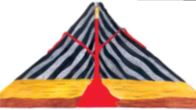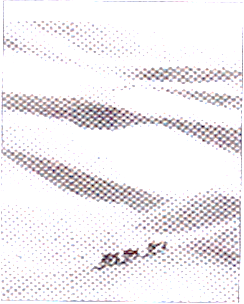Our Changing Earth - Worksheets
CBSE Worksheet 01
Our Changing Earth
- ___ is classified as a major earthquake.
- 5
- 7
- 0.5
- 2
Match the following
Column I
(a) Glaciers
(b) Sand dune
(c) Oxbow lake
Column II
(1) Crescent-shaped lake formed by the river meanders
(2) Moving mass of ice
(3) Small hills of sand(a)-(1),(b)-(3),(c)-(2)
(a)-(2),(b)-(3),(c)-(1)
(a)-(1),(b)-(2),(c)-(3)
(a)-(2),(b)-(1),(c)-(3)
- The process of erosion and deposition create
- Same landforms interior of the earth
- Same landforms on the surface of the earth
- Different landforms interior of the earth
- Different landforms on the surface of the earth
Glaciers are "rivers" of_______________
- Ice
- Wind
- Water
- Water vapour
Identify the figure given below

Glaciers
Volcano
Earthquake
Sea waves
Match the followings:
(a) Waterfall (i) Vibrations of earth (b) Earthquake (ii) Hard bedrock (c) Landslide (iii) Diastrophic force (d) Building mountain (iv) Sudden force - Fill in the blanks:
The molten magma inside the earth moves in a ________manner.
- State true or false:
Wind is an active agent of erosion and deposition in the deserts.
What do endogenic forces produce?
Name some coastal landforms.
Mention the work of ice.
Examine the work of ice.
Give an account of the work of wind.
CBSE Worksheet 01
Our Changing Earth
Solution
- (b) 7 Explanation: An earthquake of 2.0 or less can be felt only a little. An earthquake over 5.0 can cause damage from things falling. A 6.0 or higher magnitude is considered very strong and 7.0 is classified as a major earthquake.
- (b) (a)-(2),(b)-(3),(c)-(1) Explanation: Match the following
Column I - Column II
(a) Glaciers-(2) Moving mass of ice
(b) Sand dune-(3) Small hills of sand
(c) Ox bow lake-(1) Crescent shaped lake formed by the river meanders - (d) Different landforms on the surface of the earth Explanation: The landscape is being continuously worn away by two processes – weathering and erosion. Weathering is the breaking up of the rocks on the earth’s surface. Erosion is the wearing away of the landscape by different agents like water, wind and ice. The eroded material is carried away or transported by water, wind, etc. and eventually deposited. This process of erosion and deposition create different landforms on the surface of the earth.
- (a) Ice Explanation: Glaciers are “rivers of ice” which too erode the landscape by bulldozing soil and stones to expose the solid rock below. A glacier is a persistent body of dense ice that is constantly moving under its own weight; it forms where the accumulation of snow exceeds its ablation (melting and sublimation) over many years, often centuries.
- (b) Volcano Explanation: The given figure shows a volcano with magma chamber at the bottom.
(a) - (ii), (b) - (i), (c) - (iv), d - (iii)
circular
- True
Endogenic forces sometimes produce sudden movements and some other times produce slow movements. Sudden movements like earthquakes and volcanoes cause mass destruction over the surface of the earth.
Sea caves, sea arches, stacks and sea cliff.
A. Glaciers are the rivers of ice which erode the landscape by destroying sod and stones to expose the solid rock below.
B. Glaciers carve out deep hollows. As the ice melts they get filled up with water and become beautiful lakes in the mountains. The material carried by the glacier such as rocks big and small, sand and silt gets deposited. These deposits form glacial moraines.
- Glaciers are rivers of ice which too erode the landscape by bulldozing soil and stones to expose the solid rocks below.
- They carve out deep hollows.
- As the ice melts, they get filled up with water to form beautiful lakes in the mountains.
- The material carried by the glaciers like big and small rocks, sand and silt gets deposited.
- These deposits form glacial moraines.
Wind is an active agent of erosion and deposition in the deserts. In deserts, we often notice rocks in the shape of a mushroom, known as mushroom rocks. Winds erode the lower section of the rock more than the upper part. Therefore, such rocks have narrower base and wider top. When the wind blows, it lifts and transports sand from one place to another. When the wind stops blowing, the sand falls and gets deposited in low hill-like structures. These are called sand dunes. When the grains are very fine and light, the wind can carry it over long distances. When such sand is deposited in a large area, it is called loess.

